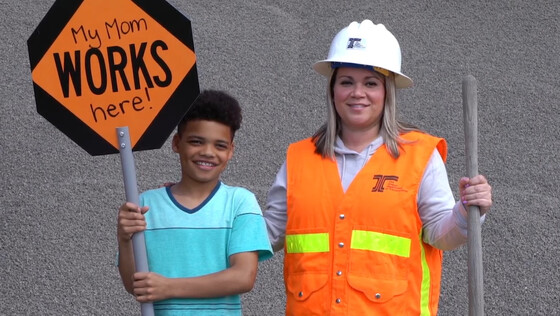ODOT workers beg you, for your own safety: Respect our work zones
National Work Zone Awareness Week is April 17-21
April 17, 2023
For more information, contact Michelle Godfrey, michelle.d.godfrey@odot.oregon.gov, 503-945-5270
SALEM -- if a car careened into your office cubicle, destroying your desk and computer and nearly missing you, you may be okay, but you’d be shaken up, to say the least.
Near misses happen every day in ODOT work zones on roads around the state. And sometimes, the cars don’t miss. Since 2016, an average of six people were killed each year in work zones; another 26 were injured because a vehicle crashed into a work zone. Each incident, devastating.
 Most of the people killed or injured in work zones were the drivers themselves, or their passengers.
“We are very concerned about safety in work zones,” said ODOT Director Kris Strickler. “Our crews are experiencing more close calls than ever, and a close call is mere inches from becoming a crash.”
Near-miss data suggests work zone incidents are more common than reported.
Driving behavior around work zones is such a concern that ODOT’s Work Zone Safety Task Force is capturing data on “near misses” to lessen the risk. A new online reporting system allows an ODOT employee or contractor with a smart phone and a QR code to report a near-miss incident. The form takes five minutes to complete, and reporting is anonymous.
While the system is in development and reporting is voluntary (so under-reporting is likely), during the pilot period from August to December 2022, the task force received 133 near-miss reports, an average of 27 incidents per month. Of those, two-thirds involved a vehicle nearly hitting equipment or crews, or a driver going around a flagger, all extremely risky behaviors for people in the vehicles and the work zones.
It confirms what workers tell us: they’re seeing more drivers speeding and driving too close for comfort in work zones. When tragedy results, it’s too much to bear…for the drivers, the workers, and the families and communities connected to them.
Most Current Crash Statistics for Oregon Work Zones
|
Year
|
Fatalities (persons killed)
|
Serious injuries
|
Any Injury (including serious)
|
Property Damage Only
|
Total Crashes
|
|
2020
|
6
|
19
|
337
|
173
|
399
|
|
2019
|
4
|
27
|
472
|
189
|
498
|
|
2018
|
8
|
26
|
585
|
228
|
585
|
|
2017
|
4
|
28
|
596
|
288
|
659
|
|
2016
|
7
|
26
|
548
|
279
|
633
|
|
2016-2020 Total
|
29
|
126
|
2,538
|
1,157
|
2,774
|
|
2016-2020 Average
|
6
|
25
|
508
|
231
|
555
|
Drive like you work there.
As Oregon marks National Work Zone Awareness Week April 17-21, we implore you: take action to keep yourself and our crews safe. If it were your own workspace, you’d protect it. We ask that you do the same for workers on the road and be alert to work zone cues.
Road crews use several technologies including automated flagging devices, mobile barriers, and portable message signs to make work zones visible and safer. That’s in addition to the traditional work zone color orange on the signs, cones and vests that road crews wear.
What can drivers do to be safe around work zones?
-
Pay attention and focus on the road. Driver inattention is a major factor in work-zone crashes.
-
Obey speed signs. Speed limits may be reduced to keep you and workers safe by giving drivers more time to react.
-
Move over. Work zone traffic lanes often are narrow, without shoulders or emergency lanes. Workers need room.
-
Plan ahead. Give yourself enough time for your trip—including possible work zone delays. Before you start, call 511 or visit TripCheck.com for the latest road conditions and work-zone information across Oregon.
-
Remember that fines double in all Oregon work zones, whether workers and signs are present or not.
Move over! It’s the law.
When you’re driving and you see flashing lights ahead, move over into the next available lane. If you’re not able to do that, you must slow down—to at least 5 mph below the speed limit. It can save lives…most likely, yours.
And since 2017, “move over” has been the law for flashing lights of any color on any type of vehicle—tow trucks, public works trucks, emergency response vehicles, hazard lights on passenger vehicles, law enforcement units or ODOT vehicles. They’re all the same.
Stay safe out there. Move over. Slow down. We’re depending on you, and our workers thank you!
###
NEWSROOMS: Videos and interview opportunities with ODOT workers
We have video stories and ODOT workers available for interviews. Each worker can share a personal story about an incident or a near-miss experienced while in a work zone.
For (horizontal) video downloads or to set up an interview, contact Michelle Godfrey, michelle.d.godfrey@odot.oregon.gov, 503-945-5270.
|